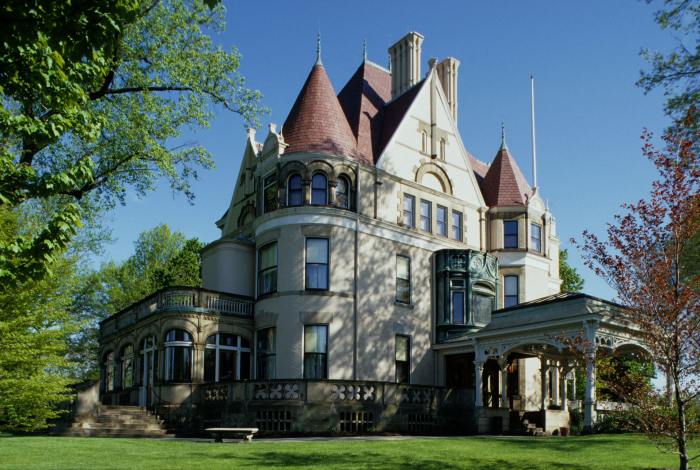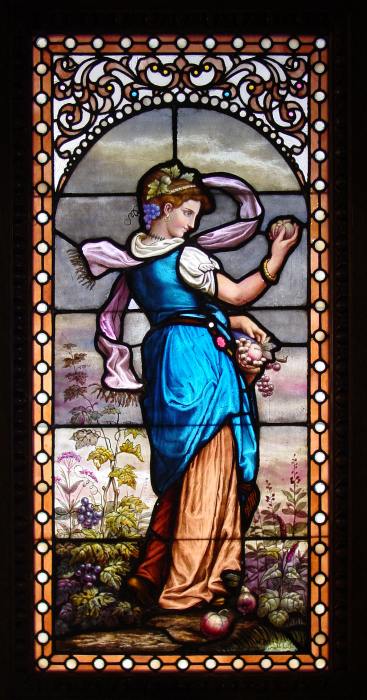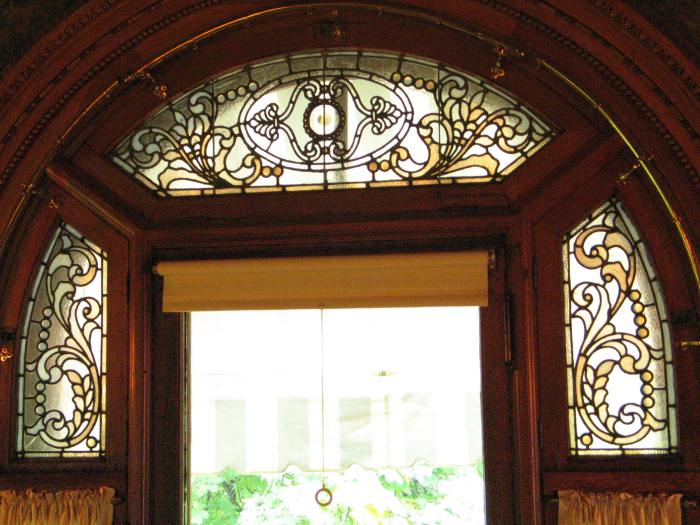
Alfred Godwin (1850-1934), Philadelphia
Alfred Godwin (1850-1934), Philadelphia: Harvest window, 1883?/1892 and
Library window 1892, Clayton, Henry Clay Frick residence; Andrew W.
Peebles (1882) and F. J. Osterling (1890-92), renovation architects
Text and photograph of Library window copyright © 2007 Pittsburgh History & Landmarks Foundation. Photograph of Clayton © 1998 William Rydberg PHOTON for Pittsburgh History & Landmarks Foundation. Photograph of Harvest by Pytlik Design Associates copyright © 2006 Frick Art & Historical Center.
In 1882 Henry Clay Frick purchased Homewood, an Italianate house in Pittsburgh’s East End. He hired Pittsburgh architect Andrew W. Peebles to supervise extensive remodeling, and D. S. Hess & Company of New York provided fashionable furniture and interior appointments. Eighteen ornamental glass windows designed and made by Alfred Godwin & Company of Philadelphia were installed in 1883: the principal window in the stairway landing, Love in the Tower; transom windows; vestibule door windows; parlor and library windows containing figures and landscapes; and a “Window Rear Hall (with figure).” Jean Farnsworth tells us that Godwin, of Manchester, England, arrived in Philadelphia in 1870. By 1882 he had established his own glass firm, and although he closed his shop in 1916 he remained active in Philadelphia well into the 1930s.
In 1890 Frick hired Pittsburgh architect Frederick J. Osterling to transform the house into a grand French château, Clayton. The enlargement/renovation was completed in 1892. Some of Godwin’s 1883 glass was retained and remounted in the remodeled interior. The figure window, Harvest, made of hand-blown (known as “antique”) and enamel-painted glass may be the window originally located in the rear hall; it received an opalescent frame. A letter of January 2, 1892, from Frick’s secretary, George Megrew, to Godwin notes that Godwin had “not sent the glass panel called ‘Harvest’ for the sliding door. Please let me know about it immediately.” A work order dated January 22, 1892, noted “ornamental work ordered added to figure for sliding door in hall”; the work was approved by F. J. Osterling on January 25, 1892.
Frick’s great-granddaughter Martha Sanger describes Harvest:
For the door between the entrance hall and kitchen quarters, A. Godwin & Company of Philadelphia, known for using semiprecious stones in stained-glass windows, provided a small golden-hued panel framed in moonstones that depicts a woman dressed in blue, holding an overflowing cornucopia.
Godwin also provided bathroom windows for Mrs. Frick and her sister Martha Childs and four three-light glue-chip or “crystalline” windows for the Library.
The Pittsburgh firm of Leake & Greene provided the opalescent glass dome and ornamental cabinet doors in Mr. Frick’s new bathroom of 1897, designed by Alden & Harlow. Godwin’s Love in the Tower was removed from the stairway (only two panels have survived and may be seen in the Frick Art Museum) when Cottier & Company of New York redecorated the house in 1903-04 and installed an antique glass Cottier window, The Four Virgins.
Windows by Alfred Godwin in Pittsburgh are especially noteworthy since Godwin played a significant part in the training of two of Pittsburgh’s leading glass artists. According to Joan Gaul, J. Horace Rudy (1870-1940) was an apprentice in Godwin’s firm 1891-1892; the period that the Clayton windows were reinstalled. In 1893, Rudy, his parents and his brothers, arrived in Pittsburgh and established Rudy Brothers Company. Rudy is important, not only for the high quality of his own work, but for his training of some of the most important American glass craftsmen of the next generation, notably Charles J. Connick (1875-1945), George W. Sotter (1879-1953) and his wife, Alice Bennet Sotter (1883-1967), and Lawrence B. Saint (1885-1961). Before William Willet (1867-1921) moved to Pittsburgh to join The L. Grosse Art Glass Company, he worked for Godwin c.1894-96. Willet’s work helped reshape the approach of the next generation of American glass artists to the glass craft in this country.
Sources: Alfred Godwin catalogues, c. 1883, c. 1890, and 1895, Athenaeum of Philadelphia and the Rakow Library, Corning, New York. “Alfred Godwin,” Stained Glass 29 (Spring/Summer 1934): 54. Helene Weis, “Some Notes on Early Philadelphia Stained Glass,” Stained Glass 71 (Spring 1976): 24-27. Jean Farnsworth, “Biographical Sketches of Stained-Glass Studios and Selected Artists,” Stained Glass in Catholic Philadelphia (Philadelphia 2002): 435-436, 456. www.philadelphiabuildings.org. Information and documentation from Robin Pflasterer, Frick Art & Historical Center. Helen Clay Frick Foundation-Henry Clay Frick Papers, Frick Art Reference Library, New York. Clayton: The Pittsburgh Home of Henry Clay Frick; Art and Furnishings (Pittsburgh 1988). Martha Frick Symington Sanger, The Henry Clay Frick Houses: Architecture, Interiors, Landscapes in the Golden Era (New York 2001): 22. 28. Joan Gaul, “Pittsburgh 1893-1912: Five Artists,” The Journal of Stained Glass 28 (2004): 47. Special thanks to Rona H. Moody and Nicholas Parrendo.
Illustrations:
- “Clayton” (1998)
- Harvest
- Library windows



